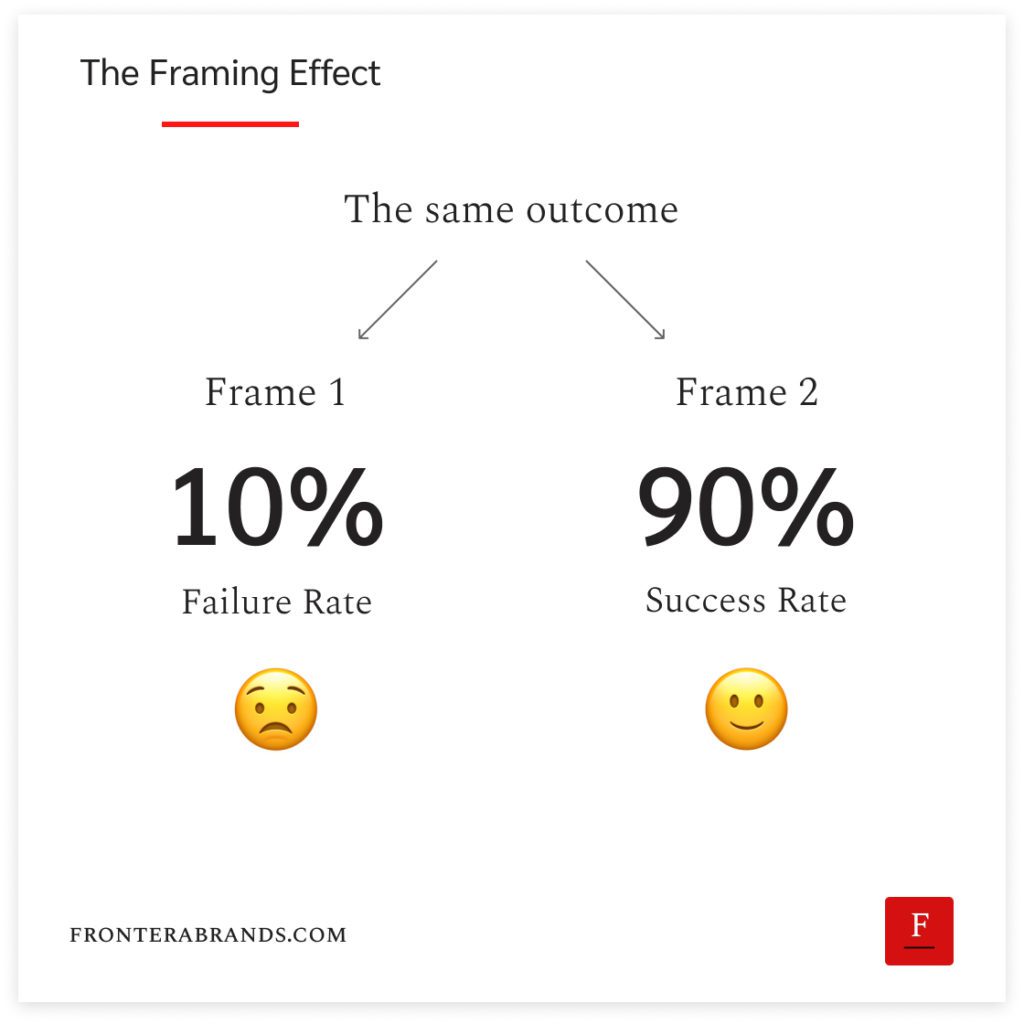You’ll remember the scene if you’ve watched Mad Men.
In the 1960s, the FTC bans tobacco companies from making any health claims in their ads.
Before that, it was normal to see ads with the “health benefits” of cigarettes.
But public opinion was starting to change on tobacco.
So Lucky Strike executives ask for help from Don Draper’s advertising agency.
How would they advertise if they can’t say cigarettes are safe?
During their meeting, Don realizes it’s one of the greatest advertising opportunities.
There are six tobacco companies with identical products.
And they can’t make any health claims.
So what they need is a different angle.
A different frame.
After asking about how they make a cigarette, he proposes to advertise Lucky Strike as “toasted.”
When the executive points out that other brands’ tobacco is also toasted, he says:
“No, everybody else’s tobacco is poisonous. Lucky Strike is toasted.”
Different frames, different opinions
We talked about mental tensions and how they affect customers’ buying decisions.
Don Draper ignored everything related to health.
And he gave consumers a new frame to justify smoking Lucky Strike.
So they didn’t think about the health issues or even believed it’s safer since it’s toasted.
The same product.
But different perceptions.
And that’s what the framing effect* is.
People have different opinions based on the framing of the same outcome.
Some other examples:
- Vintage fashion sounds more appealing than pre-owned clothing
- The Ministry of Defense sounds more positive than the Ministry of War
- 80% fat-free label sells more than 20% fat

Framing is like magic.
You give people a new perception using words.
And you influence their opinion.
It’s the core idea behind public affairs (propaganda), positioning, and how you communicate the positioning (messaging).
The one with the better frames wins.
Two Ways to Use The Framing Effect For Your Business
1. Create new frames to define your brand
In June 2023, Apple introduced Vision Pro with a big presentation.
Do you know how many times they used the term virtual reality?
Zero.
Why?
Well, every frame comes with its positive and negative associations.
Apple didn’t want consumers to have associations with “virtual reality” to assess the new product.
So they used Spatial Computing.
Marques Brownlee gives more examples in his video about Apple’s forbidden words.
Like how they prefer machine learning instead of artificial intelligence even though they heavily use AI.
Or how they have branded features.
Every phone can have durable glass.
But Apple has Ceramic Shield.
This makes Apple products less comparable to competitors.
So it’s an effective way to differentiate the brand.

Now, here’s one point.
Inventing new words for everything is not always a good thing.
You risk being unclear.
Apple has the brand recognition (and the marketing budget) to put narratives more easily into people’s minds.
But for upcoming brands, this requires a fine balance.
You have to be clear first.
And still imply that you are different.
So think about the frames you use to define your offer and brand.
Also, look at the competition’s messaging.
What are the cliché frames (benefits, features, attributes, etc.) in your category?
And what are the frames with baggage of bad associations?
Focus on changing them first — instead of inventing new frames for everything like Apple.
Dove used the beauty frame to sell soaps instead of hygiene.
Spotify used the music discovery frame instead of music streaming.
And these frames gave a different meaning to their brands while still being clear about their value.
So find clichés and frames with bad associations.
And replace them to make customers see you as unique.
2. Use the right frames for the customer’s context
Some brands try to talk to all customers the same way.
Big mistake.
Messaging strategy should consider the customer’s context.
So you can use the right frames for the context and align your touchpoints (ads, marketing/sales material, content) to increase your perceived value.
Now, what do I mean by context?
Here are three examples:
a. Different stages of the customer journey
One important context is at what stage the customer is with your brand.
If it’s pre-purchase:
Is the customer unaware of the problem/desire?
Or is he actively looking for solutions?
If it’s after purchase:
Is it a new customer who is trying to shape his opinion about your brand?
Or is it an existing customer that’s been with you for years?
At every stage, you can frame your brand in a different way to make it more valuable to the customer*:

b. Different customer segments
You know how important it is to be specific with your brand early on.
We talked about why simple brands win and the bowling alley strategy.
It simplifies everything and helps you grow faster.
But as the business grows, you inevitably get customers from different segments.
You might have enterprise and startup customers.
Or you might have customers buying your product for different purposes (e.g. business use vs. personal use, consumers vs. distributors, etc.).
That means your brand will serve different jobs for these segments.
So you should use different frames to show your brand is the right choice for their specific needs.
c. Different personas in the same segment
Sometimes even the same customer segment might have different personas.
Like different teams or roles in the same company.
B2B especially has this clear distinction.
C-suite executives or department heads are usually the buyers.
And employees are the users.
These two groups have different contexts.
So they look for different types of value.
C-suites might care more about cost, legal matters, and risk.
While employees might care more about the benefits that will make their job easier.
So the same applies here.
You must use the right frames for the right person to make your brand more valuable.
That way, you’ll give customers a good reason to choose you.
–
Enjoyed this article?
Then you’ll love the How Brands Win Newsletter.
Get the “5 Mental Models to Differentiate Your Business” guide when you join. It’s free.
References:
- The Framing Effect was coined by TVERSKY AND KAHNEMAN.
- Eugene M. Schwartz developed The Five Stages of Customer Awareness in his book Breakthrough Advertising. However, that covered only up to the conversion from a copywriting perspective.
